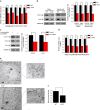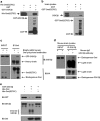The protease Omi regulates mitochondrial biogenesis through the GSK3β/PGC-1α pathway
- PMID: 25118933
- PMCID: PMC4454303
- DOI: 10.1038/cddis.2014.328
The protease Omi regulates mitochondrial biogenesis through the GSK3β/PGC-1α pathway
Abstract
Loss of the mitochondrial protease activity of Omi causes mitochondrial dysfunction, neurodegeneration with parkinsonian features and premature death in mnd2 (motor neuron degeneration 2) mice. However, the detailed mechanisms underlying this pathology remain largely unknown. Here, we report that Omi participates in the process of mitochondrial biogenesis, which has been linked to several neurodegenerative diseases. The mitochondrial biogenesis is deficit in mnd2 mice, evidenced by severe decreases of mitochondrial components, mitochondrial DNA and mitochondrial density. Omi cleaves glycogen synthase kinase 3β (GSK3β), a kinase promoting PPARγ coactivator-1α (PGC-1α) degradation, to regulate PGC-1α, a factor important for the mitochondrial biogenesis. In mnd2 mice, GSK3β abundance is increased and PGC-1α abundance is decreased significantly. Inhibition of GSK3β by SB216763 or overexpression of PGC-1α can restore mitochondrial biogenesis in mnd2 mice or Omi-knockdown N2a cells. Furthermore, there is a significant improvement of the movement ability of mnd2 mice after SB216763 treatment. Thus, our study identified Omi as a novel regulator of mitochondrial biogenesis, involving in Omi protease-deficient-induced neurodegeneration.
Figures







Similar articles
-
Loss of high-temperature requirement protein A2 protease activity induces mitonuclear imbalance via differential regulation of mitochondrial biogenesis in sarcopenia.IUBMB Life. 2020 Aug;72(8):1659-1679. doi: 10.1002/iub.2289. Epub 2020 Apr 30. IUBMB Life. 2020. PMID: 32353215
-
Inactivation of Omi/HtrA2 protease leads to the deregulation of mitochondrial Mulan E3 ubiquitin ligase and increased mitophagy.Biochim Biophys Acta. 2014 Jul;1843(7):1295-307. doi: 10.1016/j.bbamcr.2014.03.027. Epub 2014 Apr 5. Biochim Biophys Acta. 2014. PMID: 24709290
-
Omi/HtrA2 is a positive regulator of autophagy that facilitates the degradation of mutant proteins involved in neurodegenerative diseases.Cell Death Differ. 2010 Nov;17(11):1773-84. doi: 10.1038/cdd.2010.55. Epub 2010 May 14. Cell Death Differ. 2010. PMID: 20467442
-
Roles of oxidative stress, apoptosis, PGC-1α and mitochondrial biogenesis in cerebral ischemia.Int J Mol Sci. 2011;12(10):7199-215. doi: 10.3390/ijms12107199. Epub 2011 Oct 21. Int J Mol Sci. 2011. PMID: 22072942 Free PMC article. Review.
-
Role of mitochondria in diabetic peripheral neuropathy: Influencing the NAD+-dependent SIRT1-PGC-1α-TFAM pathway.Int Rev Neurobiol. 2019;145:177-209. doi: 10.1016/bs.irn.2019.04.002. Epub 2019 Jun 8. Int Rev Neurobiol. 2019. PMID: 31208524 Free PMC article. Review.
Cited by
-
Down-regulation of betatrophin enhances insulin sensitivity in type 2 diabetes mellitus through activation of the GSK-3β/PGC-1α signaling pathway.J Endocrinol Invest. 2021 Sep;44(9):1857-1868. doi: 10.1007/s40618-020-01493-1. Epub 2021 Jan 19. J Endocrinol Invest. 2021. PMID: 33464548
-
SGK1 Attenuates Oxidative Stress-Induced Renal Tubular Epithelial Cell Injury by Regulating Mitochondrial Function.Oxid Med Cell Longev. 2019 Sep 18;2019:2013594. doi: 10.1155/2019/2013594. eCollection 2019. Oxid Med Cell Longev. 2019. PMID: 31641423 Free PMC article.
-
Mitochondrial homeostasis in Parkinson's disease - a triumvirate rule?Neural Regen Res. 2017 Aug;12(8):1270-1272. doi: 10.4103/1673-5374.213546. Neural Regen Res. 2017. PMID: 28966639 Free PMC article. No abstract available.
-
Metformin inhibits Branched Chain Amino Acid (BCAA) derived ketoacidosis and promotes metabolic homeostasis in MSUD.Sci Rep. 2016 Jul 4;6:28775. doi: 10.1038/srep28775. Sci Rep. 2016. PMID: 27373929 Free PMC article.
-
Glycogen synthesis and beyond, a comprehensive review of GSK3 as a key regulator of metabolic pathways and a therapeutic target for treating metabolic diseases.Med Res Rev. 2022 Mar;42(2):946-982. doi: 10.1002/med.21867. Epub 2021 Nov 3. Med Res Rev. 2022. PMID: 34729791 Free PMC article. Review.
References
-
- Nicholls DG, Budd SL. Mitochondria and neuronal survival. Physiol Rev. 2000;80:315–360. - PubMed
-
- Lin MT, Beal MF. Mitochondrial dysfunction and oxidative stress in neurodegenerative diseases. Nature. 2006;443:787–795. - PubMed
-
- Abou-Sleiman PM, Muqit MM, Wood NW. Expanding insights of mitochondrial dysfunction in Parkinson's disease. Nat Rev Neurosci. 2006;7:207–219. - PubMed
Publication types
MeSH terms
Substances
LinkOut - more resources
Full Text Sources
Other Literature Sources
Molecular Biology Databases
Miscellaneous

